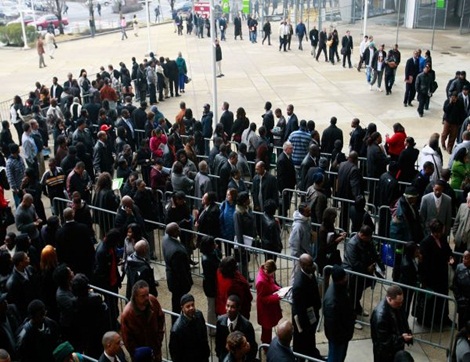
By Victor Thorn
The public must pressure its elected officials to address a growing concern that current government assessments of the unemployment rate are not accurate at all.
Much ado was made in the media that unemployment dropped to 8.3 percent in January, but there are more than a few informed observers who say the manner in which the Bureau of Labor Statistics (BLS) compiles its monthly unemployment figures is more akin to a shell game than a reliable reflection of working conditions in this country. Critics hark back to the old saying: “There are liars, damn liars and then there are statistics.”
The bottom line: The manipulated data is a vast underreporting of those who can’t find jobs, and any suggestion that the lagging economy is on the road to recovery ignores the reality that many in the lower-and middle-class face a bleak future.
For example, in calculating the unemployment rate, the BLS doesn’t include anyone that hasn’t actively searched for employment in the preceding four weeks. In addition, BLS excludes those who have given up looking for work, part-time laborers and the underemployed who seek full-time jobs but are unable to find them. Often these discouraged workers simply go on welfare or Social Security and completely drop off the map.
BLS does consider the above groups and factors in the broadest gauge of unemployment, called U6. As of January 2012, U6 is at 15.1 percent. And while this overall category is a more realistic assessment of the unemployment crisis, the mainstream media seldom uses this statistic to show the extent of joblessness in America.
CULTURAL FACTORS
To pinpoint the consequences for the average American, AFP recently spoke with an individual in the social services field, who wished to remain anonymous. When asked about long-term unemployment, he replied, “Most of the people are elderly, and they end up applying for disability or seeking early retirement. Some have health issues or undergo surgery, and when recovering their employers refuse to hire them back. Or, if a laborer has only done one job for decades and then his factory closes, he does not possess the necessary skills to easily move into another field.”
He continued: “These people are faced with a quandary. Frequently, getting on disability, food stamps, WIC [A federally-funded health and nutrition program for women, infants, and children.—Ed.] or welfare is a better alternative than accepting a minimum wage job that only provides subsistence. Plus, the government also provides medical care. The problem, though, is that they’re never able to better themselves after getting trapped inside the system.
“Right now, it’s easier to get government benefits than to rely on low-end jobs to cover all their expenses,” he said. “This country wouldn’t need such a vast welfare system if better jobs were available. With so much outsourcing, the government and corporate America hasn’t done the majority of working people any favors. A lot of them work hard, but they never get anywhere, especially when the bad economy has wiped out everything they have.”


More troubling still is the fact that those who are reentering the labor pool are compelled to take jobs that pay much less than what they previously earned.
BLS numbers reveal that the service industry accounts for a large percentage of the latest new hires that helped to lower January’s unemployment figures. Included in this figure are jobs in restaurants, bars, hotels, nursing homes and retail sales.
Although those with college educations still have (limited) opportunities, those with just a high-school diploma can only find part-time employment with no health insurance and no retirement plans.
One final question regarding the jobless rate stems from the fact that over 40 percent of the unemployed fall into what is characterized as the long-term category, i.e. more than six months without work. The problems facing these people are clear, as journalist Brad Plumer assessed on Nov. 23, 2011. “The longer they go jobless, the more likely it is they’ll lose their skills, that companies will refuse to hire them and they’ll drop out of the workforce entirely.”
DEMOGRAPHIC TRENDS
In contrast to the many out-of-work white Americans, one demographic that has made great advancements of late is the Latino community.
In a Feb. 7 article, Ray Sanchez of the news website “The Huffington Post” wrote, “Labor Department figures show that, of the 2.3 million jobs added to the economy last year, 1.4 million—60 percent—were filled by Latinos.”
The reason behind this trend is obvious: Latinos and other immigrants are more apt to accept minimum-wage, part-time or temporary jobs. Plus, being rootless, they’re more willing to relocate to other parts of the country in search of work.
In contrast, blacks have fared much worse. Many blacks in urban areas have been employed by state and local governments. And since many municipalities are facing large deficits and even bankruptcy, they’re now cutting the labor force. While the Obama administration’s stimulus package provided an artificial, temporary boost to local and state governments, these funds are exhausted, and widespread layoffs are now looming.
Considering that one in five blacks works in the public sector, unemployment among blacks stands at 16.7 percent, the highest rate in nearly 30 years.
Reporter Timothy Williams addressed another problem in a Nov. 28 column.
“The U.S. Postal Service, where about 25 percent of employees are black, is considering eliminating 220,000 positions in order to stay solvent, and areas with large black populations are struggling with budget problems that could also lead to mass layoffs,” he wrote.
Williams said that blacks have relied on government jobs ever since the Reconstruction era. Lyndon Johnson’s Great Society also dramatically expanded the public sector’s size, leading to the hiring of large numbers of blacks.
In light of a $15 trillion national debt, blacks are now facing the impact of unavoidable austerity measures.
Whatever happens, it’s not going to be pretty in major cities across the U.S. when masses of black youths are thrown out into the streets.
Joblessness Among Youth a ‘Cancer’
By Victor Thorn
One of the most distressing aspects of America’s economic stagnation is the inability of today’s youths to find a job. Recent Bureau of Labor Statistics (BLS) statistics revealed a shocking fact: The unemployment rate among America’s youth is an incredible 23.2 percent.Without this tax base, programs like Social Security—especially since so many baby boomers are now retiring—are sure to go belly up.
The Occupy Wall Street movement reflects the growing dissatisfaction among college students and graduates that they cannot find a decent-paying job.
This is a trend that is occurring around the world. Globally, today’s youths are quickly becoming a “lost generation.” In a Jan. 28 article, BBC business editor Tim Weber cited these unsettling realities.
“In some countries of the Arab world, up to 90 percent of 16- to 24-year-olds are unemployed. In Spain nearly 50 percent [of the youth are unemployed], and in the UK, 22 percent.”
Weber, reporting from the recent Davos conference, didn’t hide the feelings of corporate leaders and politicians that youth unemployment is “not [just] a crisis, but a disaster.” The general feeling is that this is a “cancer in society,” he wrote.
However, another side of this story must be told. On Feb. 9, this writer interviewed a small business owner in the trade field.
“It’s difficult right now to find skilled workers who are able to fill positions in this industry,” he said. “One company went to a local high school and made an offer to their guidance counselor: they would pay for the schooling of their graduates if they wanted jobs in this field. They got no responses.”
When asked what he attributed this lack of enthusiasm to, the owner replied: “Kids today don’t want to work in factories. Thirty years ago, people around here made a career in this kind of work and lived a good, middle-class life. For some reason, it doesn’t appeal to this generation.”
The small business owner offered another unnerving example.
“A few months ago we needed to hire a couple of new workers,” he said. “So, we placed newspaper ads while also contacting the state unemployment service. After going through the resumes, we called qualified applicants, set up interviews and basically told them that these jobs were available.”
But then his company received some odd reactions.
“One guy, upon hearing that we’d hire him, told us that he didn’t actually want the job,” he said. “He simply had to prove that he was trying to find work so he could keep collecting unemployment. . . . [H]e preferred to keep collecting checks in the mail.”
AFP inquired as to why these decisions were being made. The owner replied: “A lot of these guys aren’t lazy. Instead, since the Obama administration keeps extending the amount of time a person can collect unemployment—now up to three years—what they’re doing is getting jobs that pay under the table while still collecting unemployment checks. Since they’re working off the books at cash jobs, they don’t pay taxes. In the end, they earn just as much working part time.”
In this regard, the owner feels that extending unemployment up to three years is actually detrimental.
“A line from a movie called The Shawshank Redemption says it all: ‘A prisoner is in prison for so long they become institutionalized,’” he said. “People become so dependent on collecting checks that it eats away at their work ethic. A few decades ago, it was embarrassing to be unemployed for six weeks. Now, you can ride it for three years.”
Despite these troubling trends, the business owner did provide hope. “A few years ago, thinking that they’d save money, corporations started outsourcing the machining of parts to China,” he said. “But they ran into a huge problem. This work takes a great deal of skill, and the Chinese weren’t able to deliver quality parts. They’d send back junk, so U.S. machinists would then have to retool the parts.”
He next described why such a huge discrepancy existed: “Here U.S. workers went to trade school and have decades of experience . . . . Even though Chinese workers use the exact same equipment as we do, their skills are substandard and they churn out poor-quality junk,” he said.
“U.S. workers have a distinct advantage over the competition,” he continued. “I just wish American companies would capitalize on it better. But instead of rewarding what made this country great, companies are now turning to temp agencies that offer lower wages and few benefits rather than hiring full-time workers.”
——
Victor Thorn is a hard-hitting researcher, journalist and the author of many books on 9-11 and the New World Order. These include 9-11 EVIL: Israel’s Central Role in the September 11, 2001, Terrorist Attacks and Phantom Flight 93 and 9-11 Plot—’Made in Israel’.



